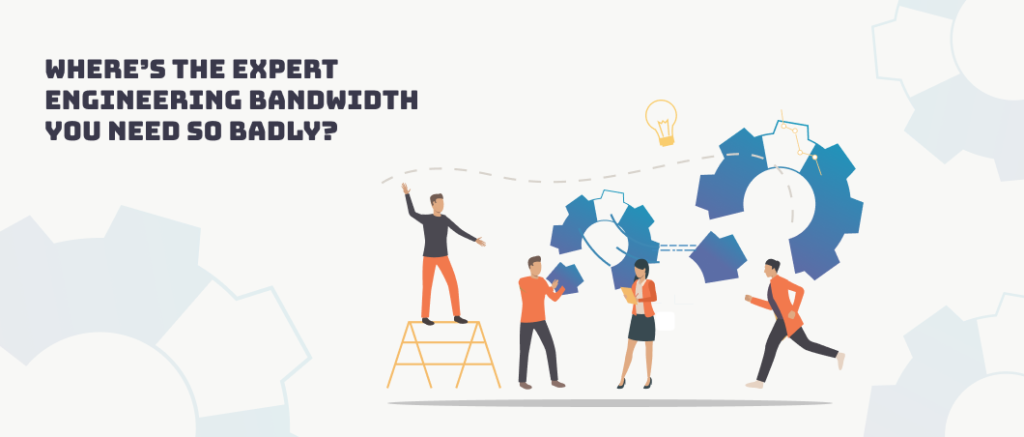Last updated on October 21st, 2024
As the post-pandemic economy looks to kick-off, product companies are looking to augment their engineering expertise to adapt to the new digital environment as well as seeking “force multipliers” to increase their engineering bandwidth. In the post-COVID business environment, there is an increased focus on remote working. Development strategies now routinely include a seamless mix of onsite, offsite, and nearshore human resources, both in-house and partner companies.
Is Team augmentation the new “mantra” for solving the engineering bandwidth challenge? What is team augmentation and how can product companies go about meeting the current challenges?
What is staff augmentation in consulting?
Staff augmentation is a flexible outsourcing strategy that enables product development companies to hire a software development team globally.
Why is staff augmentation important? During the COVID pandemic, more IT companies adopted the IT team augmentation strategy to address cost constraints as well as build more agility into their staffing plans. The strategy proved to be wildly successful as remote working models became the norm. A recent Statista report states that the global outsourcing market that was worth $92.5 billion (in 2019)grew to $132.9 billion after the pandemic.
Today, software businesses look to software team augmentation as it gives them access to top global talent with the following advantages:
- Contained costs
- No need for long-term employee contracts
- Access to software developers specialized in the latest technologies
- Ability to undertake complex product development projects
Despite its many benefits, staff augmentation takes effort to implement and has its share of challenges. Next, let us look at six major team augmentation challenges that product companies face and how they can be resolved.
- Finding the right product development partner
Today, the technology industry faces a shortage of talent. For instance, Microsoft research suggests that 69% of business organizations in the UK are currently facing a digital skills gap. Moreover, a recent Gartner report predicts that 75% of organizations will experience visible disruptions in infrastructure and operations due to technology skill shortages in the future.
Product development partners can help bridge the skill gap by providing software developers to augment the internal project bandwidth. To pick the right IT team augmentation partner, product companies must account for the following considerations:
- Location – or a partner that offers a mix of onsite, nearshore, and offsite resources who can work closely with client teams.
- Reviews – using customer testimonials and success stories that will give a fair idea of their work.
- Expertise – or a partner with expertise in product development and latest technology trends like DevOps, test automation, and serverless computing.
- Security compliance – that the team augmentation partner complies with all the relevant security standards.
- Communication barriers
Another challenge for effective team augmentation can be poor or disrupted communications with the IT team augmentation partner located in different geographical regions.
Here are some ways of addressing these communication-related challenges:
- Set up a clear and consistent communication protocol with the team at the outset.
- Use a range of communication tools like video conferencing tools (like Skype or Zoom), messaging tools (like Slack or HipChat), and task management tools (like Jira or Trello).
- Perform regular reviews of work including constructive feedback.
- Use “virtual” socializing sessions across the distributed team.
- Quality of Services rendered
Another challenge that product companies face is how do they ensure the quality of services provided by their staff augmentation partner. Will their partner meet their required quality standards?
Poor quality services can further lead to several other problems like:
- Incorrect code running into thousands of lines and bugs and carried over technical debt.
- Cost overruns because of mismatched project requirements.
- Missed deadlines in project milestones.
- Project delays can stem from missed deadlines.
- Security-related vulnerabilities because of software bugs and non-compliance to software security standards
To prevent quality-related problems, take the necessary steps including a complete background check of all shortlisted partners – along with their past project experience, companies they have worked with, and their existing skill sets. Additionally, ensure that they have a dedicated manager who is in constant touch with their software developers working on the assigned project and are well-equipped to deliver improved quality and performance to clients.
- Mismatched expectations
Does the augmented staff have the same understanding of what the finished product must look like? Mismatched expectations are among the common challenges of team augmentation that stem from differences in understanding the client’s requirements. This leads to multiple client-vendor meetings and revisions, and delays in the overall project.
When product expectations are set right initially, it creates a two-way communication channel for both sides to exchange “great” ideas, review work progress, and take corrective measures when required. In fact, team augmentation partners that provide both onsite and offsite software developers can often work more closely with product companies thereby reducing any chances of mismatched expectations.
Here are Some Tips for Setting Expectations that Will ake the investment in team augmentation worthwhile:
- Explain the project expectations using shared documents that contain all product requirements and ideas.
- Communicate every project detail and task to be performed.
- Schedule a regular project review session to check what has been completed by the team and what they are working on next.
- Monitor if the outsourcing company is sticking to its commitments and milestones.
- Lack of Institutional Memory
It’s a hot market out there for talent and people are liable to switch jobs, causing gaps due to attrition and problems with upholding institutional memory – or vital project knowledge base that utilizes project experience to avoid recurrent failures and articulate best practices.
Some projects may require a high level of contextual and institutional knowledge. For example, one of the challenges when working with a software team augmentation partner can be the loss of resources on contract termination.
This problem can be resolved if institutional memory (or project knowledge) is stored and documented for all current and future project resources. Best project practices can help new software developers learn faster and work in projects that require a high level of contextual and institutional knowledge.
- Security threats
In this age of growing cyberattacks, product companies are faced with the challenge of securing company assets and maintaining regulatory compliance even as product companies tie up with third parties. New technologies and people only add to the risks of security breaches and the data privacy of clients.
Wondering how these security challenges can be resolved? Here’s how.
- Regular security audits will ensure that everything is on track and warn of any upcoming threats by embedding security into every stage of the product development process.
- A watertight non-disclosure agreement (NDA) with technology partners will ensure the safety of the intellectual property.
- Keeping a check on any misuse of the company’s confidential information.
Conclusion
By the end of 2021, the IT outsourcing market size is projected to reach $413.7 billion. For sure this will be driven by product companies looking to leverage the benefits of team augmentation.
Want to hire software developers who will take care of product development? The highly experienced team at Forgeahead can help resolve your team augmentation challenges and reap the many benefits of this strategy. Get in touch with us right away and move closer to achieving highly anticipated business objectives.



